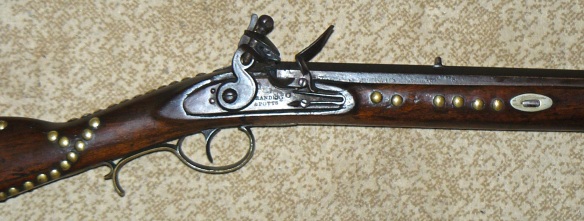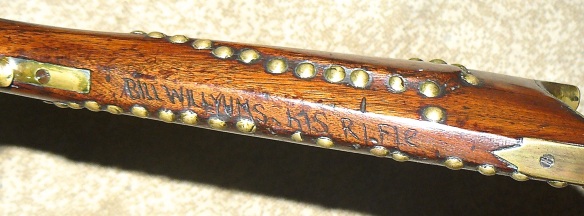By Dave Braun

The antique gun in this photo exhibits the classic lines of a J. Henry halfstock plains rifle from the mid-19th century. Its 31 inch barrel is somewhat shorter than usual for a Henry, but that was the original length. The bore is just over .53 caliber. The wide, trade gun trigger and authentic brass tacks imply a Native American connection. The top barrel flat is stamped “J P Lower Phila “. Perhaps the distributor? The bottom of the barrel is marked “H Leman Lancaster”, indicating that Mr. Henry found it more economical to outsource some of his parts rather than fabricate them in his Boulton, Pennsylvania factory. In all likelihood, this gun is an example of a contract trade rifle used somewhere on the western frontier. That’s all interesting enough, but when we flip the rifle over and install its lock, things get even better.

This classic, percussion period American plains rifle is fitted with a British flint lock! For the sake of brevity, I’ll simply assure you that several experienced collectors have carefully examined this rifle and concluded that the piece is in remarkably pristine condition. The barrel was never fitted with a percussion breech or a drum and nipple. It was never shortened. There is none of the fulminate erosion typically found on old percussion firearms. All evidence indicates that the imported Brandor and Potts flint lock is original to the rifle.
That particular 150 year old lock by the way, functions better than any modern-made flint lock I have ever seen. Each “click” is still sharp, positive and loud enough to spook game. The shower of sparks is almost scary. Over the years that I have owned and demonstrated this rifle, the frizzen has never missed fire. I think the metallurgy, hardening and tempering of the steel must be close to perfect. It’s also impressive that the light, crisp trigger release of this rifle is accomplished without the use of a detent (“fly”) in the mechanism.
So what is a flint lock doing on what would otherwise have been a state of the art percussion period rifle? And what does that imply about the use of flint ignition on other late period styles, Hawken rifles for example? We know that flintlock trade fusees were manufactured late into the 19th century, and this gun can clearly be characterized as a trade rifle. But American rifle makers were innovative, continually striving to surpass one another in style and function. A flint lock on an American half stock plains rifle is definitely a throwback.
I think the mystery might be explained with a scenario something like this. Maybe Mr. Henry had a contract to fill and the specifications weren’t very rigid. Maybe he had a few imported British flint locks laying around the shop and this gave him an opportunity to put the obsolete things to use. It’s certainly cheaper and less time consuming to produce a flint breech as opposed to one of Henry’s signature percussion design, so he saved a couple bucks on a few rifles. That hand full of flint guns found their way into a contract lot of conventional Henry percussion rifles and nobody noticed or even cared. Eventually, the guns were sent west – perhaps via J. P. Lower.
I don’t expect collectors will find many other original, flintlock, halfstock plains rifles out there. I sure wouldn’t hold my breath waiting for somebody to turn up an original flint, half stock Hawken. This flintlock Henry halfstock may very well be one of a kind, or one of very few. That makes it a pretty rare piece.
But the story of this rifle isn’t finished yet. There is still the matter of . . . the inscription.

Between the trigger guard and the toe plate are crudely carved, the words: Bill Willyums His Rifle.
Bill Williams? You mean, THE “Old Bill” Williams, famous mountain man??? That’s sure not the way Old Bill spelled his name. Could it really be? Naw! Could it?
Honestly, I’ve never taken the inscription very seriously. I’ve rather thought it more like vandalism on a cool old rifle. I’ve always imagined some kid, maybe 100 years ago, playing with an old family relic. Maybe he was inspired by a book about American frontiersmen and he just got a little carried away with his pocket knife. Or maybe the piece played a role in some local legend connected to Bill Williams, that probably had no real basis in history. I’ve discounted the possibility of intentional fraud because I didn’t pay enough money for the gun. When I bought the rifle at a Cody gun show years ago, I paid the market price for a generic half stock rifle in good condition. The dealer who sold it to me didn’t seem to even notice the inscription. Why fake something like that and then not try to jack up the price? No, my favorite theory has always been the kid with the pocket knife.
And then . . . Last summer I was re-reading George Ruxton’s novel, Life in the Far West , and it got me thinking. In his final chapter, Ruxton described the scene of Old Bill Williams’ death in 1849. He specifically mentioned Bill’s rifle being among the personal items that were recovered when Williams’ body was found. Could “Bill Willyums His Rifle” be a period way of identifying the piece as “Bill Williams’ Rifle”, carved into the stock by the semi-literate mountaineer who picked the rifle up?
Though Life in the Far West was a work of fiction, Ruxton made a point of stressing the care he took to preserve the historical accuracy of all the background events depicted in his story. He was attentive to minor details and much of what he wrote has been corroborated by other sources. In general, George Ruxton is recognized as a reliable commentator on the lives and times of the mountain men. That being said, finding Old Bill’s rifle is just the kind of plot element you would expect in a romantic story from the mid-19th century. The detail could easily be just a sentimental embellishment.
It’s impossible to actually prove a historical connection between our flintlock plains rifle and Old Bill Williams the mountain man. Even the circumstantial evidence is awfully thin. Any connection can however be definitively disproven, could it be shown that rifles of that style had not yet appeared in the mountains prior to Williams’ death in 1849.
Just when exactly did J. Henry start producing halfstock plains rifles? My intuition tells me that our rifle was made later, maybe in the mid to late ‘50s – or even a decade after that. It’s hard to tell. My opinion is based on a “feel” for the overall style of the piece and I could very well be wrong. As they say: ”If only this rifle could talk.”
What we know for sure, is that this gun was actually there – somewhere in the West during a truly amazing period in our history. That knowledge makes it a genuine thrill to handle the piece, to speculate about it and to wonder. I would sincerely appreciate the insight of any collector or student of fur trade firearms who might help shed some light on the history of this very interesting antique rifle.
You are cordially invited to inspect, handle, speculate about, psychically channel and/or otherwise play with this rifle yourself, when the Ruxton Museum and Traditional Shooting Palavar comes a rendezvous near you. See you there!

Any chance of getting any additional photos of this rifle?
LikeLike
Probably. I’ll get the message to Dave.
LikeLike
Lila, please tell Dave that this rifle was made up by J.P. Lower, He was in the business of assembling trade rifles from bought out gunshops, military weapons and current manufactures of half stock parts. The stock and forends certainly look like a Slotter product, which he used for most of his half stock work. Locks were a matter of choice for his customers, and I’m not surprised that he used a flint one here. From 1850 through 1855, he work as a gunsmith with J.C. Grubb of Philadelphia, later going on the road for Grubb drumming. He went to the nations with these rifles, built in his home shop. He also had Deringer copies, also built from parts in his shop. Although the rifle follows the lines of a Henry, the true makers name is on the barrel flat.
LikeLike
I’ve always been very interested in the Lower connection to this rifle. I recently saw a photo of a J.P. Lower rifle that made me question my original identification of this gun as a Henry. I think it would be very profitable for us to talk. What is your experience with J.P. Lower rifles? Perhaps we could unravel a bit more of the actual history of this gun. Thanks for checking out our site!
Best wishes,
Dave Braun
LikeLike
Andy, Didn’t we just look at a photo of a rifle with decorative triangular groupings of circular stamps similar to those on “Old Bill”? Was that rifle made by J.P. Lower?
Dave
LikeLike
Did you ever take any additional photos of this rifle?Thanks Tony Bertolino
LikeLike
I used to shoot with the Bill Williams people in the early 1980s and only ever ate one egg raw . I missed ! Well , they told me that Bill Williams was a rascal and wondered off one day , and his body was never found . They were good people , and it was always a fun time .
LikeLike